Our Beloved Lang Hall
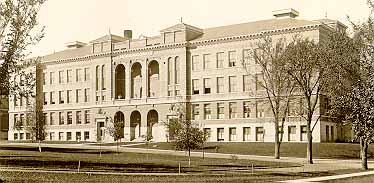
Early UNI Campus
Lang Hall was the fourth classroom building to be constructed at UNI. When the school opened for the first time in 1876 as the Iowa State Normal School, the campus was very small. It consisted of one main building, Central Hall, and several smaller buildings.
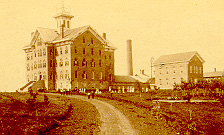
The second classroom building to be constructed was old Gilchrist Hall in 1882. It was built to the south of Central Hall. In the 1884 photo below, old Gilchrist Hall appears on the left.
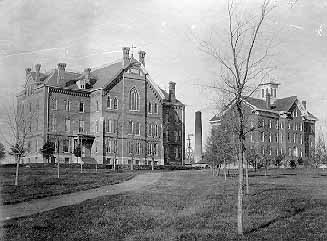
In 1894, the third classroom building was constructed on campus. The Administration Building was set to the east between Gilchrist Hall and Central Hall.
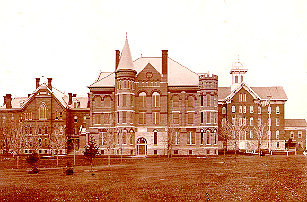
Then in 1900, ground was broken for the fourth building. Lang Hall is the only remaining building of the original four.
Planning and Construction
Construction: 1900-December 1901
Cost:$120,000
Architects: Proudfoot and Bird
Lang Hall was to be constructed north of the Administration Building and northeast of Central Hall.
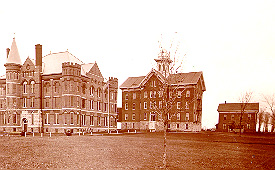
Below is the architect's drawing of the Normal School's new building. It was known as the Auditorium Building until 1995. In that year, it was renamed Lang Hall.
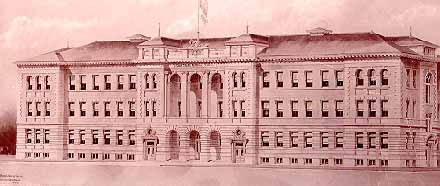
At some point, a pocket-sized souvenir booklet was published that contained a brief description of the building and floor plans. Below is the physical description printed in the booklet.
THE STATE NORMAL NEW BUILDING.
PROUDFOOT & BIRD, ARCHITECTS
THE BUILDING has a frontage of 229 feet and is 146 feet from front to rear through the center. It has three stories and a basement, all with high ceilings and contains an auditorium, seating 2,000; a gymnasium 70 x 78 feet, fifty class rooms, recitation rooms and offices, and six large society halls.
The building is designed in the Renaissance [sic] Style and will be constructed in the most thorough manner with steel girders and brick partition walls throughout.
The exterior walls will be faced with Bedford Stone and mottled pressed brick, and the roof will be covered with slate. The interior wood-work will be done with quartered red oak and the floors and stairs will be hard maple.
The building will be equipped with a modern system of steam heating and fan ventilation, including automatic temperature controlling apparatus.
A complete system of baths and sanitary plumbing will be installed.
To view early floor plans of Lang Hall, choose one of the links below.
Basement ---- First Floor ---- Second Floor ---- Third Floor
Dedications
The building's cornerstone was set into place November 13, 1900. Cornerstones serve as time capsules, storing carefully selected artifacts for future generations. Here is a list of items sealed in Lang Hall's cornerstone by the Board of Trustees:
Contents of Lang Hall Cornerstone
- Report of Superintendent of Public Instructions, 1896-97 and 1898-99
- State Normal School Bulletin, 1888-1900
- Biennial Reports Iowa State Normal School, 4th to 12th inclusive
- Summer Term Circulars, 1897-1900
- Iowa Educational Directory, 1895-1900
- Memorial to Hon. Edward Townsend, Member of Board of Trustees, 1894-1900
- Program of Cornerstone Ceremonies
- Seerley and Parish's History and Civil Government of Iowa
- Rich's New Practical and Higher Arithmetic
- Faculty Lists, 1900-01
- Program of Recitations, 1900-01
- Gilchrist's Memorial Addresses
- Sabin's "Making of Iowa"
- National Educational Association Report of Committee on Normal Schools
- Melendy's History of Cedar Falls
- Y.M. & Y.W.C.A. Hand Book for 1900
- Constitution of Y.W.C.A. of United States of America
- Greeting Letter from Y.W.C.A.
- Cedar Falls Record; Cedar Falls Gazette; Cedar Falls Globe
- Journal of House, and Journal of Senate, stating the passage of the bill which gave the $100,000 to the Normal School
- Baccalaureate and other Addresses by H.H. Seerley
- Wright's Drill Book in English Grammar, Teachers' Manual of Arithmetic, and Geometrical Exercises
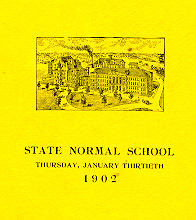 The ceremony itself consisted of musical numbers presented by the Normal School Orchestra, the Men's Glee Club, and the Normal School Cadet Band. The students present at the exercises also sang "The Song of Iowa" as the cornerstone was put into place. Speakers at the event were Professor D. Sands Wright, giving the historical address, and Reverend A. Cato Kaye of Oskaloosa, Iowa, giving the cornerstone address.
The ceremony itself consisted of musical numbers presented by the Normal School Orchestra, the Men's Glee Club, and the Normal School Cadet Band. The students present at the exercises also sang "The Song of Iowa" as the cornerstone was put into place. Speakers at the event were Professor D. Sands Wright, giving the historical address, and Reverend A. Cato Kaye of Oskaloosa, Iowa, giving the cornerstone address.
Construction on Lang Hall was completed by 1902. Off-white colored invitations were sent out "cordially" inviting individuals to the official opening and dedication of the new building on January 30, 1902. In the bright yellow dedication program shown here were the program of the day's events, a menu of the food to be served at the reception, and the dedicatory exercises. Music was provided by the Normal Orchestra, the Cecilian Glee Club, the Normal Choir, and the Choral Society. Although others spoke briefly at the event, Governor A. B. Cummins gave the dedicatory address.
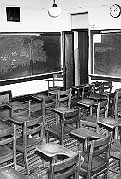 Inside Lang Hall
Inside Lang Hall
This three-story structure contained fifty classrooms, like the one to the right, recitation rooms, and offices, plus six large society rooms.
The basement contained a gymnasium for men that was 70' x 78'.
The society rooms were used by literary societies. The room shown below belonged to the Shakespearean Society. Although it is difficult to see in this photo, very detailed designs exist around the top of the walls and on the ceiling.
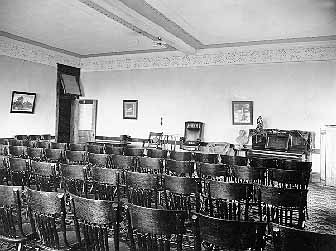
The new society halls were dedicated in their own special ceremony on January 29, 1902. At that time, ten men's and women's literary societies existed on campus. Honorable I. J. McDuffie, member of the Board of Trustees, addressed the societies at the event.
Beautifully designed ceilings exist throughout the building. In the photo of the stairway below, notice the ceiling's detailed design.
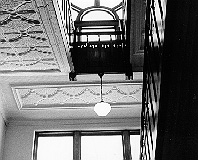
Another notable feature of Lang Hall are the two large bas-relief reproductions of commemorative plaques from the Soldiers' and Sailors' Monument at the State Capitol in Des Moines. The bas-reliefs were first located in the Administration Building.
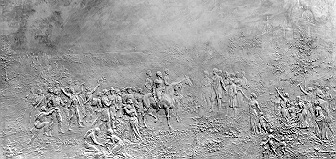
The Auditorium
Lang Hall was probably most known for it's large 2,000-seat auditorium.
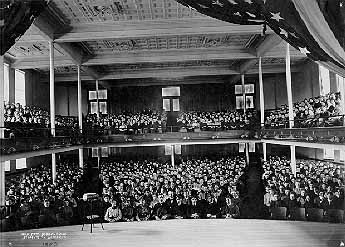
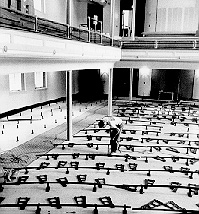 In the above picture, students and faculty members fill the room for the building's dedication on January 30, 1902. The photo was taken from the stage.
In the above picture, students and faculty members fill the room for the building's dedication on January 30, 1902. The photo was taken from the stage.
In May 1986, $485,000 was allotted to UNI for renovating the auditorium and making other repairs. In the photo to the right, a worker is beginning to install new seating in the lower section.
Before the renovation, the auditorium had three main sections with no center aisle. When the renovations were complete in October 1986, the seats had been arranged into four sections with a main aisle down the center. Currently, the auditorium contains only 1,000 seats. The photo below was shot from the same vantage point as the 1902 photo above.
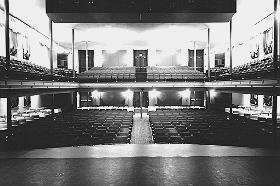
Activities and Events
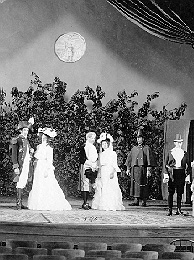 Many college events have been held in Lang Hall's auditorium over the years, including theatrical productions, musical concerts, and meetings.
Many college events have been held in Lang Hall's auditorium over the years, including theatrical productions, musical concerts, and meetings.
One of the first plays to be presented in the auditorium was "The Rivals" on June 16, 1902. The production, shown to the left, was part of the students' Class Day Program.
"The Messiah" was performed by the Iowa State Teachers College glee clubs in 1930. C. A. Fullerton directed the 300 voices from the Cecilians, Bel Cantos, Euterpeans, Aeolians, Minnesingers, and Troubadours vocal groups. As you can see in the photo below, a large pipe organ was installed in the stage area at some point.
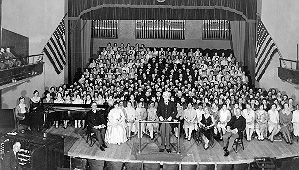
Many of the school's musical groups also performed in the auditorium. Below, an early Men's Band poses for a picture on the auditorium stage.
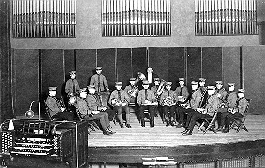
A Connected Campus
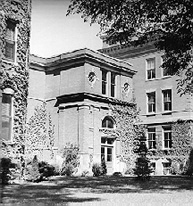
At one time, three of the main classroom buildings were connected by a series of corridors. This network of corridors, called the Crossroads, connected Lang Hall (on the right in this photograph) to the Administration Building and Central Hall. The short structure next to Lang Hall is the Crossroads. Most of this area remains today, long after the other two buildings were removed.
The Crossroads was built to protect the female students from bad weather and having to climb stairs, and also to ease the administration of the buildings.
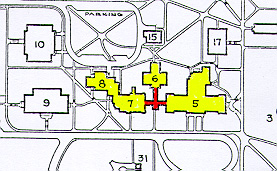
On this 1953 map, the Crossroads is highlighted in red. Building number five is Lang Hall and number six is Central Hall. Buildings seven and eight, the Administration Building and old Gilchrist Hall, were also connected by a hallway. In the early days, an elevated corridor also existed between buildings eight and six.
Lang Hall Dedication
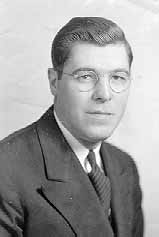
Lang Hall was originally known as the Auditorium Building. Later, as it was showing signs of age, the UNI community referred to it as the Old Aud. It was not until September 1994, that the Iowa State Board of Regents unanimously voted to rename the building in honor of a former UNI Vice President and dedicated professor, William C. Lang.
The dedication ceremony was held May 6, 1995. Individuals speaking at the event included John W. Johnson, President Constantine Curris, former President J.W. Maucker, and Professor Donald Whitnah. Lang's daughters, Mary and Barbara, also spoke briefly.
Renovations on Lang Hall, which are estimated to cost around $9,629,000, will begin in the summer of 1998 and take approximately twenty-six months to complete. The architects in this project have attempted to create a design which will retain the historical aspects of the building, if possible.
Actual display and web version created by Susan A. Basye
Special Collections and University Archives
January 1998; March 1998
